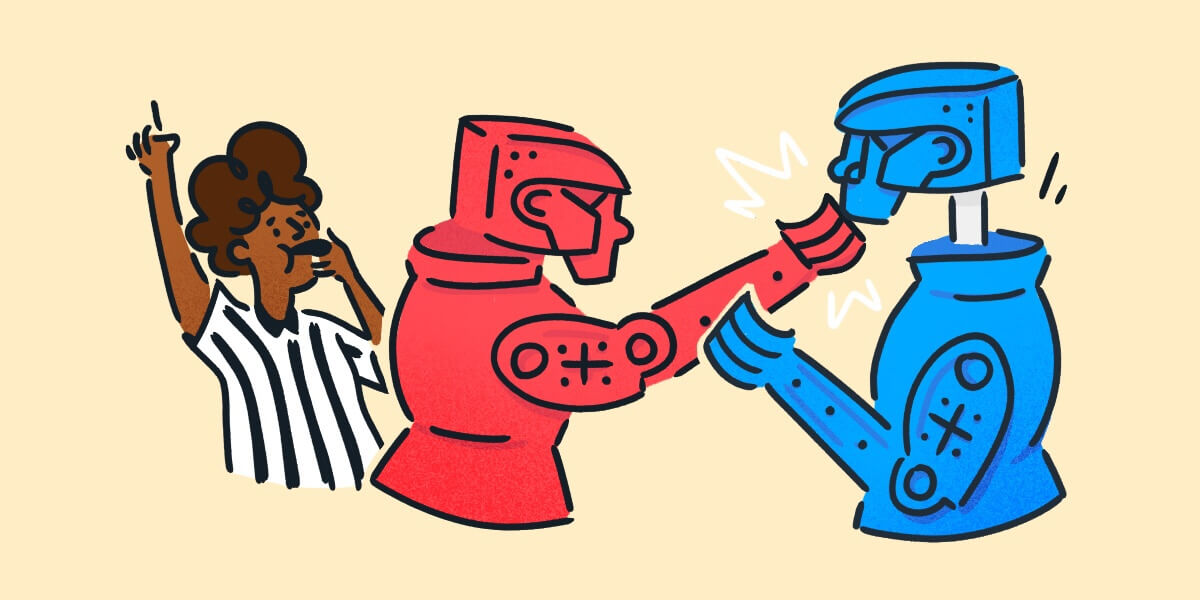Conflict management can be one of the most fraught elements of a manager's job. Employees can get worked up, and underlying problems in your workplace are often revealed in the course of a conflict resolution discussion. How you manage conflict can be a great opportunity for you to solve your company's problems and bolster team morale, but they can also make your team lose confidence and respect in your management if handled poorly.
That's why it's necessary for all managers to learn conflict management skills.
A common misconception is that it is emotionally sensitive or emotionally intelligent people that are the best at handling these situations. But emotional intelligence doesn't mean you'll automatically be great at handling conflicts in the workplace. Like all kinds of communication skills, conflict management skills have to be learned and practiced by every manager. This article will outline skills that you can take into the workplace to turn your conflicts into opportunities for bettering your workplace and your team.
1. Spot signs of conflict
Being proactive about handling conflicts starts with knowing how to spot them. One key conflict resolution skill is working to resolve conflicts before they worsen. Heading off a conflict early will make it easier to resolve and cut any effects of the conflict short. While it's tempting to focus on your own feelings of discomfort, and work to avoid causes of conflict, managers play an important role in keeping the personal relationships within their team strong. When problems are left to linger, people will feel worked up and resentful, making it harder for everyone to work together to move forward. But if you don't see a conflict early or you do but don't address it, that problem is likely not going away on its own. And, by failing to address the problem, you will be signaling to your team that you don't know what is happening, don't care about what is happening, or can't solve problems effectively.
Common signs of team conflict situations:
- Work is consistently turned in late
- The quality of work drops
- Unexpected requests to change groups, projects, assignments
- Communication between team members changes: casual conversations wane, while teammates talk more about work, but in more negative terms
- Issues brought up in 1:1 meetings that have never come up before
- Uptick in sick days and requests for time off
- Tardiness, longer or more frequent breaks
An unexpected behavioral shift is usually a sign that something is afoot. It's your job as a manager to pick up on deviations from the normal behavior of your team and then set out to find the cause. In this case, trying to address the problem before it happens could even up your interpersonal skills, and prepare you for harder conflict resolution situations in the future.
2. Separate the “what” from the “why”
In their book Getting To Yes, Roger Fisher, William Ury, and Bruce Patton state: "Your position is something you have decided upon. Your interests are what caused you to so decide." This is a very important distinction to make when trying to handle a conflict. What has happened or what people decided to do is necessary to discuss, but why someone decided to do those things is just as important, because the why is the root cause of the what.
Say a pair of co-workers working on a presentation are running into an interpersonal conflict. At its head, one of them — Agnes — redoes the entire presentation on her own, erasing her colleague Martha's work. The “what” is clear: Agnes redid the presentation. But why? If you ask Agnes, her root motivation is that she wants the presentation to be as good as possible and she felt the presentation they made together wasn't working. If you ask Martha why she is upset, part of the problem is Agnes' disrespect for her work and opinion, and part is that she, too, wants the presentation to be as good as possible and doesn't think Agnes' approach will make that happen. As a manager, it's your job to identify this common ground to help these colleagues resolve differences. Try starting at the fact of what happened and moving down, like so:
Agnes, I'd like to understand the challenges you experienced working on the presentation with Martha.
- Why did you decide to make a new presentation? What were the roadblocks you were trying to overcome?
- What did you hope the end result of your actions would be?
- How do you think Martha felt when she saw the new presentation?
- Did you consider other options? Why did you decide against the other options?
- What are next steps you would take now to resolve your current conflict around this presentation?
Martha, what happened with your and Agnes's presentation?
- What roadblocks did you experience when putting the presentation together? How did you attempt to solve them before Agnes made a new presentation?
- What did you hope the end result of your actions would be?
- Upon reflection, are there other options you think might have produced a different outcome?
- What are steps you would take now to resolve your current conflict around this presentation?
These lines of questioning will help clarify each perspective and cut the scenario down to the bone. Ultimately, both Agnes and Martha want their work to be good, their workplace to be comfortable, and their projects to be successful. The way they go about it might be different, but uncovering the motivation — the why — can help you as a manager to solve a conflict, even when their approaches — the what — are different. And that's why it's important to separate the what and the why. It unearths the common ground and forms the basis for working together towards a solution.
3. Ask the right questions
Discussing a conflict with your direct reports is tricky. You need to be open, listen, and ask smart questions to get to the core issue. To do that, you need to think carefully about how you phrase your questions when you are talking about a conflict.
- Avoid placing immediate fault or blame, especially when talking to one person about a group effort: “Why didn't you finish this project on time?” vs “What issues came up that slowed down this project?”
- Emphasize that people should share their own perspective and do not speak for others: “What, in your eyes, would you change about the project procedure next time?” vs “How should we change the project procedure?”
- Follow-up questions are almost always necessary, and should push people to think beyond their actions. Try a sequence like: What happened?, Why did it happen?, What circumstances enabled the why?, and Is this an isolated problem or a pervasive one?
The most important thing is to give your employees space to share their perspective and their concerns without putting words into their mouths or placing blame. This should be the basis for opening your discussion up to help your employees see their conflicts clearly and identify solutions together.
4. Frame discussions objectively
Conflicts can bring up strong emotions, and conflict in the workplace is no exception. A good manager will understand that people get emotional and acknowledge their employees' feelings. Sometimes, active listening is the most effective communication when it comes to conflict resolution. Just being heard can make employees feel better.
But emotions alone cannot be the basis for problem solving, especially in a case where both sides have emotions running high. For workplace conflict, the best way to keep emotions under control when dealing with a conflict is to return to objective points in discussing the problem and the solution. Start going back to the baselines:
- What are the parameters of each job?
- What is the end goal of the project?
- What are the expectations for workplace conduct?
- How are measurable results being affected?
This reframes conflict discussion to be a conversation towards a solution to a problem, rather than a negotiation only anchored in personal feelings. Even employees who simply do not get along will understand the responsibilities of their job and workplace and be able to agree that everyone would like to get on with their work. While this is particularly helpful for localized discussions of conflict, it's also something that can be useful to integrate into your day-to-day with employees. Brent Tworetzky, SVP of Product Management at InVision, says: “I’ve found that once you start framing your daily negotiations in a principled approach instead of a battle of wills, negotiations feel a lot less stressful or personal.”
5. Make the hard decisions
Although there will be conflicts that you can solve with a compromise that makes everyone more or less happy, there will also be situations where you cannot please all parties. In these cases, you need to use your understanding of your team, your goals, and your superiors to come up with the solution that has the most benefit, even if it comes at a cost. When you find yourself in a tough spot and need to come down on one side or another:
- Keep your decisions in line with company values
- Use historical precedent where appropriate
- Keep documentation of the problems and their effects
- Emphasize the positives of the decision
- Be willing to hear out concerns, and prepare counterpoints
- Be the one to communicate the decision to all affected parties yourself
Making hard decisions far outweighs letting problems fester. And when you can come up with a solution that provides the most good and demonstrate why it is appropriate, you are building trust with your employees by showing them you are consistently trying to do what is best for the team, even if they don't love the decision itself.
Don't psych yourself out
Nobody wants to deal with workplace conflict. But you can set yourself up for success by preparing well and learning successful ways to handle conflict when it appears in front of you. Nobody magically knows how to solve every problem in the workplace — it's about the intention, dedication, and sensitivity that you display when you come up with a problem that counts.







